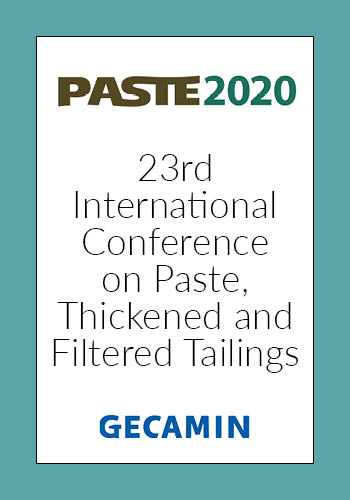Surface cracking in thickened tailings: mechanisms and its influence on evaporation and water contents

|
Authors: Arredondo, E; Suazo, G; Araya, V |
DOI https://doi.org/10.36487/ACG_repo/2052_103
Cite As:
Arredondo, E, Suazo, G & Araya, V 2020, 'Surface cracking in thickened tailings: mechanisms and its influence on evaporation and water contents ', in H Quelopana (ed.), Paste 2020: 23rd International Conference on Paste, Thickened and Filtered Tailings, Gecamin Publications, Santiago, https://doi.org/10.36487/ACG_repo/2052_103
Abstract:
Tailings Storage Facilities (TSF) are characterized by high moisture contents of their materials even after thickening processes. After deposition the tailings undergoes to a series of phenomena such consolidation, seepage, desiccation, etc., which results in the desaturation of the pore space. The occurrence of these phenomena is influenced by several factors, such as evaporation, contraction and surface cracking. Particularly, it has been found that the surface cracking affects evaporation rates while influencing the stability of the facility due to the desaturation of deeper soil layers. Nowadays, the assessment of water content in the field is a complex and sometimes not viable activity due to risk of personnel when moisture content is controlled manually. Knowing the moisture content can be advantageous if the stability of the facility needs to be evaluated or the water balance of the structure analyzed. So, one question that arises is: can the water content of the facility being indirectly monitored through the observations of cracks? The latter is explored in this article by conducting desiccation tests in paste tailings under temperature and field conditions of northern Chile. The slurry is desiccated until the shrinkage limit is exceeded while RGB images captured periodically and rated of evaporation monitored. The images are then processed utilizing segmentation, linear filtering, and thresholding techniques. The processed images of the laboratory samples are then compared with images captured by unmanned aerial vehicle (UAV) in a paste storage facility. Finally an index that correlates cracking and moisture content is proposed. In addition to this, a new approach to estimate shrinkage limit is proposed.
References:
Ferrer, G. (2011). Estudio del comportamiento sísmico de relaves espesados mediante el análisis de columna unidimensional, considerando grietas de contracción. Pontificia Universidad Católica de Chile - Escuela de Ingeniería.
Fredlund, M. D. (1999). The Role of Unsaturated Soil Property Functions in the Practice of Unsaturated Soil Mechanics.
Fujiyasu, Y., Fahey, M., & Newson, T. (2000). Field Investigation of Evaporation from Freshwater Tailings. Journal of Geotechnical Engineering, 126(June), 556–567.
Konrad, J.-M., & Ayad, R. (1997). An idealized framework for the analysis of cohesive soils undergoing desiccation. Canadian Geotechnical Journal, 34(4), 477–488.
Rodríguez, R., Candela, L., & Lloret, A. (2005). Experimental System for Studying the Hydromechanical Behavior of Porous Media. Vadose Zone Journal, 4(2), 345.
Rodríguez, R., Sánchez, M., Ledesma, A., & Lloret, A. (2007). Experimental and numerical analysis of desiccation of a mining waste. Canadian Geotechnical Journal, 44(6), 644–658.
Simms, P., Dunmola, A., & Fisseha, B. (2009). Generic predictions of drying time in surface deposited thickened tailings in a “wet” climate. Tailings and Mine Waste, 749–758.
Zhang, M. F., Wilson, W. G., & Fredlund, D. G. (2018). Abstract : Canadian Geotechnical Journal, 55(2), 191–207.
© Copyright 2024, Australian Centre for Geomechanics (ACG), The University of Western Australia. All rights reserved.
View copyright/legal information
Please direct any queries or error reports to repository-acg@uwa.edu.au
View copyright/legal information
Please direct any queries or error reports to repository-acg@uwa.edu.au